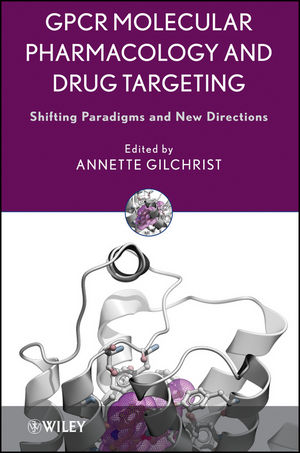GPCR Molecular Pharmacology and Drug Targeting: Shifting Paradigms and New DirectionsISBN: 978-0-470-30778-6
Hardcover
560 pages
August 2010
 This is a Print-on-Demand title. It will be printed specifically to fill your order. Please allow an additional 10-15 days delivery time. The book is not returnable.
|
||||||
Contributors.
1. The Evolution of Receptors: From On–Off Switches to Microprocessors (Terry Kenakin).
1.1. Introduction.
1.2. The Receptor as an On–Off Switch.
1.3. Historical Background and Classical Receptor Theory.
1.4. The Operational Model of Drug Action.
1.5. Receptor Antagonism.
1.6. Specific Models of GPCRs (7TM Receptors).
1.7. The Receptor as Microprocessor: Ternary Complex Models.
1.8. Receptors as Basic Drug Recognition Units.
1.9. Receptor Structure.
1.10. Future Considerations.
References.
2. The Evolving Pharmacology of GPCRs 27 (Lauren T. May, Nicholas D. Holliday, and Stephen J. Hill).
2.1. Agonists, Neutral Antagonists, and Inverse Agonists.
2.2. LDTRS/Protean Agonism.
2.3. Molecular Mechanisms of GPCR Ligand Binding.
2.4. Two GPCR Ligands Binding at Once—Concept of Allosterism.
2.5. GPCR Dimerization.
2.6. Future Perspectives.
Acknowledgments.
References.
3. The Emergence of Allosteric Modulators for G Protein-Coupled Receptors (Karen J. Gregory, Celine Valant, John Simms, Patrick M. Sexton, and Arthur Christopoulos).
3.1. Introduction.
3.2. Foundations of Allosteric Receptor Theory.
3.3. Models for Understanding the Effects of Allosteric Modulators.
3.4. Types of Allosteric Modulators and Their Properties.
3.5. Detection and Quantification of Allosteric Interactions.
3.6. Some Examples of GPCR Allosteric Modulators.
3.7. Concluding Remarks.
References.
4. Receptor-Mediated G Protein Activation: How, How Many, and Where? (Ingrid Gsandtner, Christian W. Gruber, and Michael Freissmuth).
4.1. The Mechanical Problem—Three Different Solutions.
4.2. Receptor Monomers–Dimers–Oligomers: One Size Fits All?
4.3. Corrals, Fences, Rafts—Are There Privileged Places for GPCR Activation?
Acknowledgments.
References.
5. Molecular Pharmacology of Frizzleds—with Implications for Possible Therapy (Gunnar Schulte).
5.1. Introduction.
5.2. Frizzleds as WNT Receptors.
5.3. Frizzled Signaling 120.
5.4. Frizzleds—Physiology and Possible Therapy.
Acknowledgments.
References.
6. Secretin Receptor Dimerization: A Possible Functionally Important Paradigm for Family B G Protein-Coupled Receptors (Kaleeckal G. Harikumar, Maoqing Dong, and Laurence J. Miller).
6.1. Methodological Approaches to GPCR Oligomerization.
6.2. Structural Themes for GPCR Oligomerization.
6.3. Functional Effects of GPCR Oligomerization.
6.4. Secretin Receptor Oligomerization.
References.
7. Past and Future Strategies for GPCR Deorphanization (Angélique Levoye, Nathalie Clement, Elodie Tenconi and Ralf Jockers).
7.1. Introduction.
7.2. Current Strategies to Identify the Ligand and Function of Orphan 7TM Proteins.
7.3. Functional Assays for Deorphanization.
7.4. Future Directions and New Concepts.
7.5. Controversial Issues.
Acknowledgments.
References.
8. High-Throughput GPCR Screening Technologies and the Emerging Importance of the Cell Phenotype (Terry Reisine and Richard M. Eglen).
8.1. Introduction.
8.2. How Are GPCR Drugs Discovered?
8.3. GPCR Dependence on G Proteins.
8.4. Technologies for GPCR Compound Screening and Drug Discovery.
8.5. Importance of Target Cells in GPCR HTS Assays.
8.6. Summary.
References.
9. Are "Traditional" Biochemical Techniques Out of Fashion in the New Era of GPCR Pharmacology? (Maria Teresa Dell’anno and Maria Rosa Mazzoni).
9.1. Overview.
9.2. Receptor Binding Assays.
9.3. Methods for Measurement of cAMP.
9.4. Conclusions.
References.
10. Fluorescence and Resonance Energy Transfer Shine New Light on GPCR Function (Carsten Hoffmann and Moritz Bünemann).
10.1. Overview.
10.2. Introduction.
10.3. Labeling GPCRs with Fluorescent Tags.
10.4. Detection of Fluorescence and Bioluminescence.
10.5. Fluorescence-Based Assays to Study Receptor Localization, Trafficking and Receptor Function.
10.6. Resonance Energy Transfer, a Tool to Get New Insights into GPCR Function.
10.7. Analysis of Steady-State Protein–Protein Interaction by Means of RET.
10.8. Kinetic Analysis of Protein–Protein Interactions by Means of FRET.
10.9. Detection of Receptor Function by Fluorescence Resonance Energy.
References.
11. Integration of Label-Free Detection Methods in GPCR Drug Discovery (Oliver Nayler, Magdalena Birker-Robaczewska, and John Gatfield).
11.1. Overview.
11.2. Introduction.
11.3. Label-Free Technologies—Past and Present.
11.4. Discussion.
Acknowledgments.
References.
12. Screening for Allosteric Modulators of G Protein-Coupled Receptors (Christopher Langmead).
12.1. Introduction.
12.2. The Allosteric Ternary Complex Model, Radioligand Binding, and Affinity.
12.3. Beyond Affinity—Functional Assays, Efficacy, and Allosteric Agonism.
12.4. Allosteric Modulator Titration Curves.
12.5. The Impact of Functional Assay Format on Allosteric Modulator Screening.
12.6. Taking Advantage of Structural Understanding of Allosteric Binding Sites.
12.7. Summary and Future Directions.
References.
13. Ultra-High-Throughput Screening Assays for GPCRs (Priya Kunapuli).
13.1. Introduction.
13.2. Assay Types for GPCRs in uHTS.
13.3. Summary.
Acknowledgments.
References.
14. New Techniques to Express and Crystallize G Protein-Coupled Receptors (James C. Errey and Fiona H. Marshall).
14.1. Introduction.
14.2. Key Problems Limiting Production of 3D GPCR Structures.
14.3. History of GPCR Structures.
14.4. The Search for Other GPCR Structures.
14.5. Protein Purification and Solubilization.
14.6. In Cubo Crystallization.
14.7. Engineering Receptor Stability.
14.8. Structures of the â2AR.
14.9. The Adenosine A2a Receptor.
14.10. Conclusions and Future Developments.
Acknowledgments.
References.
15. Structure and Modeling of GPCRs: Implications for Drug Discovery (Kimberly A. Reynolds, Vsevolod Katritch, and Ruben Abagyan).
15.1. Introduction.
15.2. High-Resolution GPCR Modeling.
15.3. Constructing and Evaluating Homology Models of Other Receptor Types.
15.4. Modeling GPCR Functional Features—Analysis of Activation and Signaling.
15.5. Beyond Class A: Modeling of Other GPCR Families.
15.6. Summary and Conclusions.
Acknowledgments.
References.
16. X-Ray Structure Developments for GPCR Drug Targets (Michael Sabio and Sidney W. Topiol).
16.1. Overview.
16.2. Introduction.
16.3. Class A GPCRs.
16.4. Class C GPCRs.
16.5. Conclusions.
References.
17. Pharmacological Chaperones: Potential for the Treatment of Hereditary Diseases Caused by Mutations in G Protein-Coupled Receptors (Kenneth J. Valenzano, Elfrida R. Benjamin,Patricia René, and Michel Bouvier).
17.1. Overview.
17.2. Introduction.
17.3. NDI and the V2R.
17.4. RP and the Rhodopsin Receptor.
17.5. IHH and the Gonadotropin-Releasing Hormone Receptor.
17.6. Other Human Diseases Caused by Inactivating Mutations in GPCRs.
17.7. Considerations for the Therapeutic Use of Pharmacological Chaperones.
17.8. Concluding Remarks.
Acknowledgments.
References.
Index.



